Apr 13, 2025
Apr 13, 2025
Curiosity is a natural instinct. The human mind is always curious about the past life and environment. The present hullabaloo about the environment has enhanced the human curiosity to know more and more about the past. Questions like what must have been the past life like and what must have been the environment like often bug the human mind. The paleontologists are always on the look out for traces of hitherto unreported life from rocks considered 'barren'. A chance discovery from one such succession of rocks from Rajasthan, recently has opened new vistas for exploring the past. We all know life exists where living conditions are congenial. In other words life exists at places where the environment is suitable. Identification of such remains of the life of the yore is however, quite a difficult task. Imagine a cockroach walking on a sand tray. Depending upon the conditions the insect will walk, run or rest at some places. He would leave his foot prints accordingly. Likewise millions of years ago when the life existed under water mostly, some of the organisms walked on the sea bed or river bed, leaving their foot prints on the sands of time. Their foot prints were fossilized by the nature's processes and preserved for the posterity. These are supposed to be the marks left by Trilobites, a group of arthropods (insects) that became almost extinct some 355 million years ago at the end of the Devonian period of the earth's history. One order of Trilobites (Proedita), however, escaped and survived till the Permian and became extinct with the Permian extinction some 250 million years ago. Whereas Rusophycus type of marks are created when the animal is resting after a good meal! The soft sand on the sea-bed was their home and they enjoyed a meal of worms freely.
Dulmera is a non-descript locality on Bikaner-Ganganagar Road in Rajasthan. Recently marks were found on the surface of the sandstones present there which were found to be the foot-prints of the ancient organisms 'Trilobites'. Some 540 million years ago it seems the sandstones then soft sands under the sea had the creatures walking on them in abundance. These sandstones were so far considered as lifeless by the paleontologists. Prof S. Kumar and S.K. Pandey of the Centre of Advanced study of Geology at Lucknow University, Lucknow were excited with their find. They published their findings in the April 2008 issue of the Current science.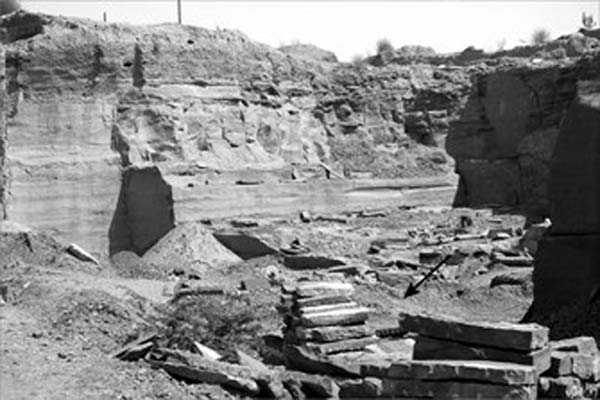
A ticklish task for a paleontologist is to ascertain the species of the organism that left the foot prints on the sands. But as we learn from the present that human foot prints are quite different from that of a tiger foot prints, the paleontologists have managed to develop a system, whereby it is possible to identify the organism that left the marks on the sand. Per chance if the body fossils of the animal are also found in the vicinity the job of the paleontologists becomes easier. Profusion of insects at a given place indicates that the living conditions were really congenial. Rocks, after all are not so lifeless that they appear to be!
It is common sense that rivers carry the eroded material and dump it in the sea. Layers after layers of sand are thus deposited. These layers undergo a natural process of lithification to form the sedimentary rocks like sandstone. Organisms thriving on the surface of the sand layer are buried under the influx of sand and under given condition are fossilized. They serve as indices of establishing the age of the rocks and the process of evolution. In addition one can recreate the environment in which they lived.
Rajasthan has a widespread and thick succession of sandstone which is placed by the geologists under Marwar Supergroup. There are about 1000 m thick sandstones. It is amazing to imagine the huge pile of sediments that was formed under the oceans once upon a time. It is still more amazing to imagine that myriads of creatures were traversing upon the sand under the sea! The sandstones are apparently devoid of any fossils and under lain by volcanic rocks which have been dated between 770-681 million years. It is thus implied that the sandstones are younger than 68o m. y.
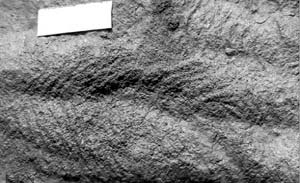 Kumar and Pandey were fortunate to have discovered four varieties of trace fossils or the foot prints, identified as Cruziana, Rusophycus, Dimorphicnus, and Aulichnites.
Kumar and Pandey were fortunate to have discovered four varieties of trace fossils or the foot prints, identified as Cruziana, Rusophycus, Dimorphicnus, and Aulichnites.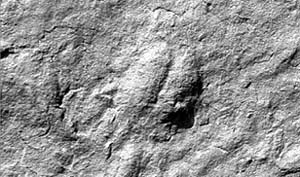 The tenacity of the insects makes one wonder sometime that in the present day world despites humans killing self with insecticides the insects on the other hand continue to proliferate! That is why perhaps one order of Trilobites managed to survive for nearly 100 million years despite drastic environmental changes, including sea water temperatures and salinity.
The tenacity of the insects makes one wonder sometime that in the present day world despites humans killing self with insecticides the insects on the other hand continue to proliferate! That is why perhaps one order of Trilobites managed to survive for nearly 100 million years despite drastic environmental changes, including sea water temperatures and salinity.
As already said fossils are markers of age. Those organisms which have a widespread distribution and live for a shorter duration are considered to be more precise and accurate for determining the ages of the layers of rocks. They are termed as Index Fossils.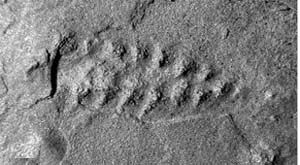
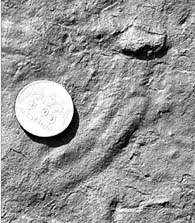 Though body fossils of trilobites have yet to be found from the sandstone at Dulmera, the 'trails' left by them will certainly lead the paleontologists to locate the swarms of Trilobites and to further refine the study.
Though body fossils of trilobites have yet to be found from the sandstone at Dulmera, the 'trails' left by them will certainly lead the paleontologists to locate the swarms of Trilobites and to further refine the study.
Cruziana and other trails found at Dulmera have been reported from other parts of the world as well. The age of 540 million years was in fact confirmed by those reports. This was an age when the earth's history was being written. This was a period when life on the Globe (in the sea rather) had begun to diversify. First 40 million years of this period saw a variety of life forms evolve, including some organisms with hard body parts. Soft bodied organisms are not fossilized except under very special circumstances like in amber.
This was the period when light had begun to penetrate the oceans. Light is a life creator and more and more forms developed. The hot saline ocean too had begun to become more congenial for the life to thrive. This led to the phenomenon of 'Cambrian explosion'. It was something like 'human explosion' of the present day. Those days instead of humans (we had not evolved then) insects and other organisms multiplied like contemporary humans and perished.
Trilobites proliferated under the sea and could not survive the environmental changes / catastrophes. Their fossils are present in the sandstone which are used to make our houses. May be after a million year our fossils are discovered from our houses buried under the sea!
Let us not multiply like insects; else we will face the same fate as of trilobites.
27-Jun-2008
More by : V. K. Joshi (Bijji)